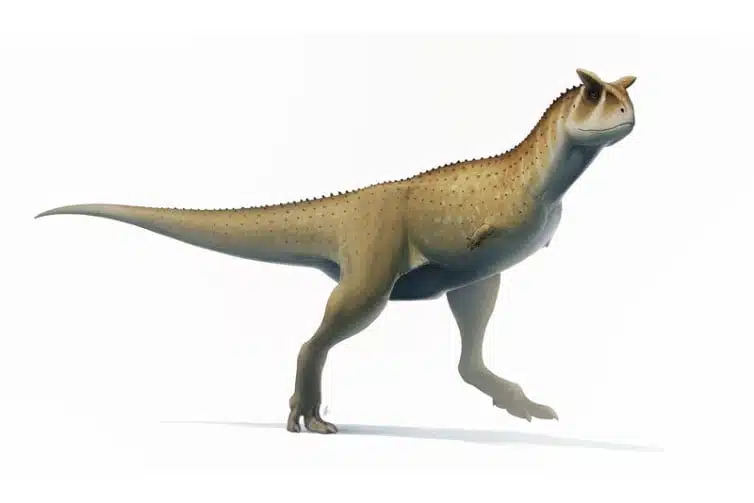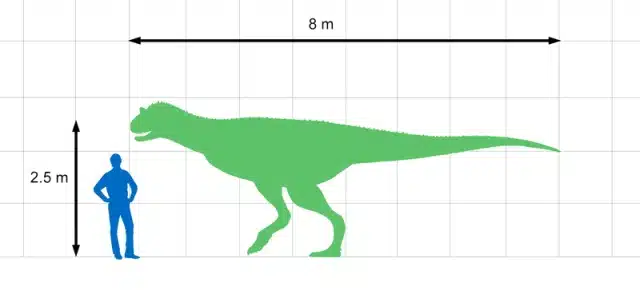Carnotaurus, whose name fittingly translates to “meat-eating bull,” was a formidable predator, roaming Earth during the Late Cretaceous Period. Its distinctive horns and muscular build set it apart from other dinosaurs, making it a fascinating subject of study for paleontologists.
Carnotaurus is a testament to the diversity and adaptability of life on Earth. It was a creature perfectly suited to its environment with features that enabled it to thrive in the harsh conditions of the prehistoric world. Its unique characteristics, such as its horns and remarkably short arms, continue to intrigue scientists and dinosaur enthusiasts alike.
Carnotaurus Key Facts
| Keyword | Fact |
|---|---|
| Carnotaurus pronunciation | kahr-noh-TAWR-uhs |
| Meaning of name | “Meat-eating bull” |
| Group | Theropods |
| Type Species | Carnotaurus sastrei |
| Diet | Carnivore |
| When it Lived | 72.1 to 66.0 MYA |
| Period | Late Cretaceous |
| Epoch | Maastrichtian |
| Length | 25.0 ft |
| Height | 10.0 ft at hips |
| Weight | 1.0 to 2.0 tons |
| Mobility | Moved on two legs |
| First Discovery | 1985 by José Bonaparte |
| Location of first find | Chubut Province, Argentina |
| First Described by | 1985 by José Bonaparte |
| Holotype | MACN-CH 894 |
Carnotaurus Taxonomy and Timeline

Carnotaurus, whose name means “meat-eating bull,” is a fascinating creature from the annals of prehistory. Its name is derived from the Latin words “carno,” meaning meat, and “taurus,” meaning bull. This name is a fitting description of this large predator, which is known for its distinctive horns and carnivorous diet.
In terms of taxonomy, Carnotaurus belongs to the group of dinosaurs known as theropods. These dinosaurs were primarily carnivorous and moved on two legs. It is part of the family Abelisauridae and is the only known member of its species, Carnotaurus sastrei.
It lived during the Late Cretaceous period. This was a time of significant change on our planet, with the continents drifting apart into the positions we are familiar with today and the climate becoming cooler.
Fossil Evidence
The first fossils of Carnotaurus were discovered in 1985 in the Chubut Province of Argentina. The discovery was made by José Bonaparte, a renowned paleontologist known for his extensive work on South American dinosaurs. The fossil was remarkably well-preserved, providing valuable insights into the physical characteristics and lifestyle of this unique dinosaur.

Since the initial discovery, additional fossils have been unearthed and added to our understanding of this unique dinosaur. These fossils have included various skeletal remains, providing a more complete picture of its physical structure. The degree of preservation of these fossils has varied, with some specimens being more intact than others.
One of the most notable specimens is the one discovered by Bonaparte. This specimen was remarkably well-preserved, with nearly 70% of the skeleton intact. This level of preservation is rare in dinosaur fossils, making this specimen particularly valuable for scientific study. The specimen included the skull, spine, and limbs that give a comprehensive view of its physical characteristics.
Carnotaurus Size and Description
This carnivore was a large theropod dinosaur, known for its distinctive horns and muscular build. Its body was streamlined, with a deep chest and a strong, flexible tail that likely aided in balance and maneuverability. It had a large head with a pair of horn-like structures above its eyes that likely would have given it a menacing appearance.
Its neck was strong and muscular to support the weight of its large head. The vertebrae were robust and provided a sturdy framework for the dinosaur’s body. It had remarkably short arms, even shorter than those of the T. rex. Despite their small size, these arms were muscular and likely served a specific, yet currently unknown, purpose. Its skin was rough and scaly, similar to that of modern reptiles.
Size and Weight of Type Species

Carnotaurus was a large dinosaur, with estimates of its length reaching up to 25 feet. Its height is estimated to be around 10 feet at the hips. As for its weight, estimates vary, but it’s believed to have weighed between 1 and 2 tons. These estimates are based on the size of the fossils found and comparisons with similar dinosaurs.
However, it’s important to note that these are just estimates. The actual size and weight could have varied. Some individuals may have been larger or smaller than these estimates. Despite these uncertainties, there’s no doubt that it was a formidable predator and one of the largest of its time.
Carnotaurus Games
Test (and refresh) your knowledge about Carnotaurus and other dinosaurs by playing this fun quiz:
Don’t forget to try our other games as well!
The Dinosaur in Detail
Carnotaurus is a dinosaur that truly stands out. Its unique features set it apart from other dinosaurs, reflecting its adaptability and survival instincts. One of the most distinctive features of Carnotaurus is its horns. These horn-like structures, located above its eyes, are unlike anything seen in other theropods. They may have been used for display or combat, showing off to potential mates or intimidating rivals.
Another unique feature of Carnotaurus is its remarkably short arms. These arms were even shorter than those of the T. rex, another theropod known for its small arms. Despite their size, these arms were muscular and may have served a specific purpose. Some scientists speculate that they could have been used for balance during high-speed chases, while others suggest they may have played a role in mating displays.
It also had a deep chest and a strong, flexible tail. These features likely contributed to its speed and agility, making it a successful predator. The deep chest would have provided space for large, powerful muscles and the flexible tail could have been used for balance and maneuverability during high-speed chases.
Carnotaurus Illustration Sketch
Carnotaurus in its Natural Habitat
It lived during the Late Cretaceous period, a time when the Earth was undergoing significant changes. The continents were drifting apart and the climate was becoming cooler. Despite these changes, it was able to thrive in its environment.
Carnotaurus was (obviously) a carnivore, meaning it fed on other animals. Its diet likely consisted of smaller dinosaurs and possibly even others of its own kind. Its speed and agility, combined with its unique hunting strategies, would have made it a formidable predator.
It was a bipedal dinosaur, meaning it moved on two legs. This would have given it a speed advantage over quadrupedal dinosaurs and allowed it to chase down prey or escape from danger quickly. Its strong, flexible tail would have aided in balance and maneuverability during high-speed chases.
South America was not so different at the time. It likely lived in a warm, humid environment, similar to modern-day rainforests. This environment would have been rich in vegetation, and provided ample cover for this predator to ambush its prey. The dense vegetation would have also provided a habitat for a variety of other dinosaur species, contributing to a diverse and complex ecosystem.
Interesting Points about Carnotaurus
- It had a pair of horn-like structures above its eyes, a feature that is unique among theropods. These horns may have been used for display, combat, or possibly even as weapons against prey.
- Despite being a large predator, it had remarkably short arms. These arms were even shorter than those of the T. rex.
- It had a deep chest and a strong, flexible tail. These features likely contributed to its speed and agility, making it a formidable hunter.
- It had a kinetic skull, meaning different parts of the skull could move to reduce stress on the bone. This is considered to be the most kinetic dinosaur skull known.
- The eyes were angled slightly forward, enabling it to see in stereoscopic vision. This is a common feature of predatory animals and allows for depth perception, which is crucial when hunting prey.
Contemporary Dinosaurs
Carnotaurus was not the only South American dinosaur roaming the land in the Late Cretaceous. Its contemporaries included both Aucasaurus, Abelisaurus, and Noasaurus, each unique and playing their part in the ecosystem.
Aucasaurus, smaller yet no less significant, might have found itself in a delicate dance of survival with Carnotaurus. Their similar diets could have led to tense encounters, a silent contest of wills under the ancient sun. Yet, the slightly smaller stature of Aucasaurus may have forced it to yield to Carnotaurus.
Abelisaurus, another contemporary, presents an interesting contrast. Its size is comparable to Carnotaurus and suggests a potential rivalry. Could they have been competitors, each vying for the same resources? Or perhaps their paths rarely crossed, their lives unfolding in parallel yet separate narratives. Noasaurus was another theropod that likely occupied a different niche, avoiding direct competition with Carnotaurus. Yet, its presence added another layer to the complex ecosystem that Carnotaurus navigated.
In this dynamic world, Carnotaurus, Aucasaurus, Abelisaurus, and Noasaurus coexisted, their lives intertwined in a complex web of survival, competition, and coexistence. Their interactions, though lost to time, continue to fascinate, offering a glimpse into a world that once was. Through them, we gain a deeper understanding of Carnotaurus’s life and the environment it thrived in, a testament to the enduring allure of these prehistoric giants.
List of All Dinosaurs
We have created a list of all dinosaurs we have covered here, sorted across the seven main groups of dinosaurs. We also include information about their type of diet, (omnivore, herbivore or carnivore) and the time they lived.
Frequently Asked Questions
The name translates to “meat-eating bull,” a fitting description for this formidable predator.
The Carnotaurus lived during the Late Cretaceous period.
As a carnivore, it fed on other animals. Its diet likely consisted of smaller dinosaurs and possibly even other Carnotaurus.
It was a large dinosaur, with estimates of its length reaching up to 25 feet. Its height is estimated to be around 10 feet at the hips.
It had several unique features, including a pair of horn-like structures above its eyes, remarkably short arms, and a kinetic skull. These features set it apart from other dinosaurs and reflect its adaptability and survival instincts.
Sources
- https://www.researchgate.net/publication/279703141_A_rational_for_phylogenetic_definitions_with_application_to_the_higher_level_taxonomy_of_Dinosauria
- https://royalsocietypublishing.org/doi/10.1098/rspb.2004.2692
- https://www.sciencedirect.com/science/article/abs/pii/S0195667115301439
- https://www.nature.com/articles/s41598-018-28154-x
Article last fact checked: Joey Arboleda, 06-11-2023
Featured Image Credit: Copyright (c) Thedinosaurs.org
